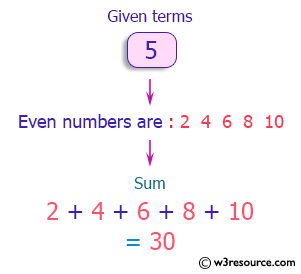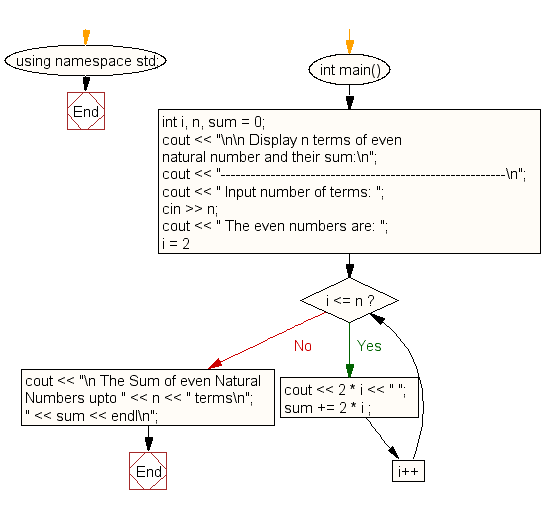C++ Exercises: Display the n terms of even natural number and their sum
21. Sum of n Even Natural Numbers
Write a C++ program that displays the sum of the n terms of even natural numbers.
Visual Presentation:

Sample Solution:-
C++ Code :
#include <iostream> // Including input-output stream header
using namespace std; // Using standard namespace to avoid writing std::
int main() // Start of the main function
{
int i, n, sum = 0; // Declaration of integer variables 'i' (loop counter), 'n' (user input for the number of terms), 'sum' (sum of even natural numbers)
cout << "\n\n Display n terms of even natural number and their sum:\n"; // Display message on the console
cout << "---------------------------------------------------------\n";
cout << " Input number of terms: "; // Prompt the user to input the number of terms
cin >> n; // Read the input value as the number of terms
cout << "\n The even numbers are: "; // Display message indicating the list of even numbers
for (i = 1; i <= n; i++) // Loop for 'n' terms
{
cout << 2 * i << " "; // Print the even numbers by formula 2 * 'i'
sum += 2 * i; // Add the even number to the sum variable
}
cout << "\n The Sum of even Natural Numbers up to " << n << " terms: " << sum << endl; // Display the sum of even numbers up to 'n' terms
}
Sample Output:
Display n terms of even natural number and their sum: --------------------------------------------------------- Input number of terms: 5 The even numbers are: 2 4 6 8 10 The Sum of even Natural Numbers upto 5 terms: 30
Flowchart:

For more Practice: Solve these Related Problems:
- Write a C++ program to display the first n even natural numbers and calculate their sum.
- Write a C++ program that reads n and prints even numbers from 2 to 2n, then computes their total sum.
- Write a C++ program to generate and sum the first n even numbers using a for loop with arithmetic progression.
- Write a C++ program that outputs an array of n even numbers and then prints the aggregate of these numbers.
Go to:
PREV : Sum of n Odd Natural Numbers.
NEXT : Display n Terms of a Harmonic Series and Their Sum.
C++ Code Editor:
Contribute your code and comments through Disqus.
What is the difficulty level of this exercise?
